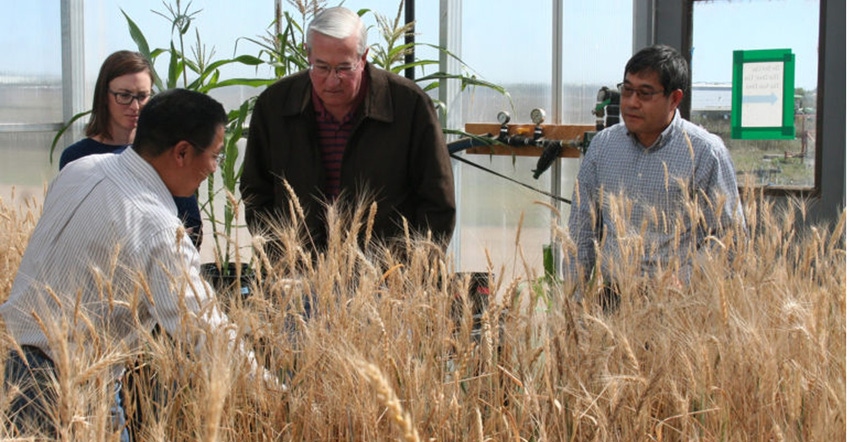
When new pests, diseases or environmental issues are identified in Texas wheat, expertise in doubled haploid development can help find solutions in less than half the time of traditional breeding practices.
Chenggen Chu, a geneticist, joined Texas A&M AgriLife Research’s wheat program at Amarillo two years ago, and his doubled haploid wheat pure lines are already making it to field yield trials this fall.
Since moving to Amarillo, Chu has built a wheat doubled haploid production pipeline from scratch that can be shared with AgriLife Research’s wheat breeding programs in both Amarillo and College Station. He is training other personnel on the process.
The major advantage of using doubled haploid plants is to shorten the time in developing genetically pure lines from five to six years in a traditional winter wheat breeding scheme, to only two or three years, said Shuyu Liu, AgriLife Research wheat geneticist, Amarillo.
“Texas A&M’s wheat breeding programs are very strong, but did not include anyone with the skills Dr. Chu brought with him,” Liu said. “The wheat doubled haploid line development procedures require some skilled steps in the laboratory.
“It also requires a special growth room and lab equipment for inducing haploid embryos, growing plants from young haploid embryos, doubling chromosome numbers to bring back the fertility, and recovering plants to grow in soil for seed production.”
What is doubled haploid?
Double haploid simply put is all about speeding up the process to access specific traits and getting them into farmers’ fields faster.
Traditional wheat has both parents from wheat lines and has two sets of wheat genetic material or chromosomes. This is called a diploid. In the general procedure for wheat doubled haploid production, corn was used as the father to pollinate the mother wheat plants.
During embryo development, only one set of chromosomes from the wheat mother plant is kept and the other set of chromosomes from the father corn is lost. These embryos with a single set of chromosomes are haploids and are highly sterile, producing almost no seed.
However, through an induced chromosome doubling process – the skill that Chu brings to the program – the haploids can produce another copy of chromosomes in each cell, bringing the chromosome numbers back to the normal two sets per cell and fully restoring their fertility.
This doubled haploid process turns the haploid to the regular diploid with two sets of chromosomes that are identical. The identical sets of chromosomes in each cell makes doubled haploid lines 100% genetically stable, even after being reproduced for many generations.
“This genetic stability, regardless of time and location, makes trait evaluation more accurate and reliable for breeders,” Chu said.
Doubled haploids in the field
Chu has been able to optimize the procedures to increase efficiencies on both haploid plant induction and chromosome doubling. He led the genetic team working with Texas A&M’s two wheat breeding programs in College Station and Amarillo, and he produced more than 1,300 doubled-haploid lines in the first season from about 40 crosses.
The team has now finished the second season and harvested over 700 lines. The first set of 550 lines were increased for seed in Yuma, Arizona, and have been planted in multiple locations this fall for yield trials.
Liu said the process isn’t without challenges, as with any crop. The 2018 summer was very good for growing doubled haploid plants in the greenhouse in Bushland, but this past summer many plants did not produce enough tillers after they were transplanted in the greenhouse in July due to the stressful, hot environment.
But what it does mean is Texas A&M’s wheat breeders and geneticists are already using these wheat crosses to develop advanced breeding lines and gene mapping populations.
“The total time from growing the F1 plants to planting doubled haploid lines in multiple locations for yield trials has been less than two years, which saves at least three years when compared with the conventional one generation advance per year,” Liu said.
Next steps
“We would like to keep the trained personnel and established procedures and a facility to continue doubled haploid production to meet the requirements from both breeding and genetic research,” Liu said. “But that takes funding.”
He said they are currently working on two U.S. Department of Agriculture-National Institute of Food and Agriculture projects where doubled haploids are involved to develop pure lines with target genes.
At the same time, Chu is working to optimize the procedures further to increase the efficiency of doubled haploid development.
“We greatly appreciate the funding support from the Crop Improvement Program of Texas A&M AgriLife Research during the last two years and the continuous support from Texas Wheat Producers Board,” Liu said.
Such funding, he said, will be key to keeping skilled technicians and a facility with controlled light and temperature conditions in place.
Source: is AgriLife TODAY, which is solely responsible for the information provided and is wholly owned by the source. Informa Business Media and all its subsidiaries are not responsible for any of the content contained in this information asset.
About the Author(s)
You May Also Like




